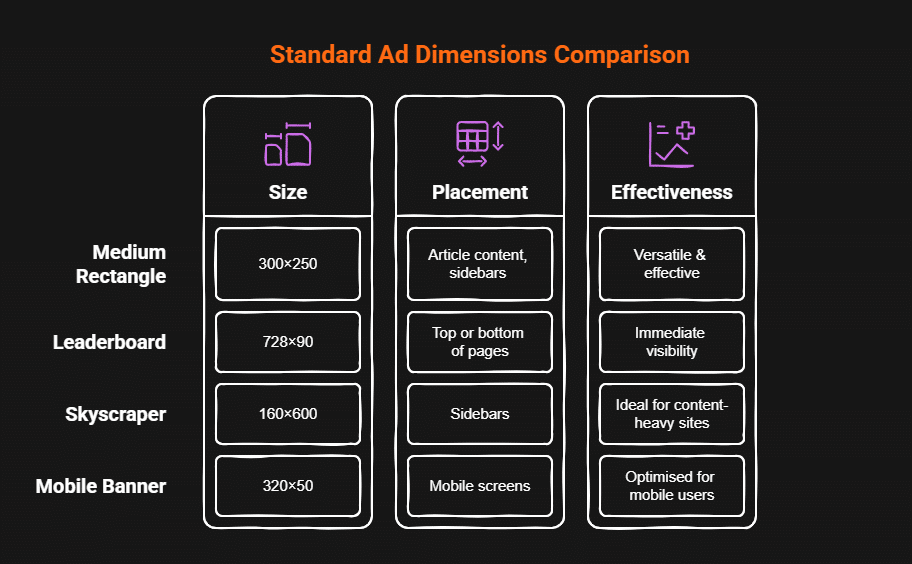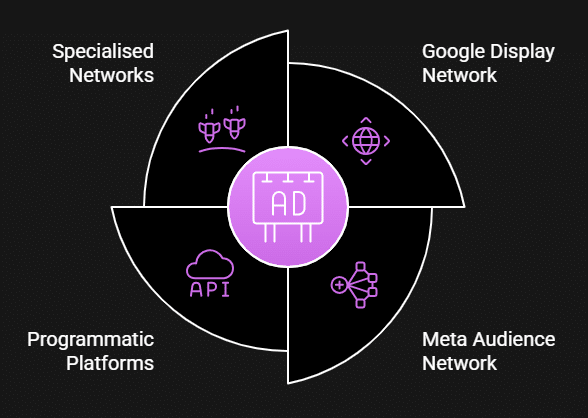Display advertising remains a cornerstone of digital marketing strategy for brands, but too many businesses waste ad spend on ineffective creative, imprecise targeting, and outdated tactics.
Key Takeaways
- Advanced targeting strategies ensure your display ads reach the right audience, combining demographic, behavioural, and contextual targeting to reduce wasteful ad spend and boost conversion rates.
- Creative best practices including strategic visual design, compelling CTAs, and message hierarchy significantly impact ad performance, with proper use of white space and brand consistency driving better engagement.
- Emerging ad formats like rich media, video, and responsive display ads combat banner blindness and fatigue, helping your brand stand out.
- A/B testing of headlines, visuals, and CTAs following a concrete schedule enables continuous optimisation of display campaigns.
- Privacy compliance and preparing for cookieless targeting are crucial in 2025, with successful brands leveraging first-party data and contextual approaches to maintain performance while building customer trust.
Understanding display advertising fundamentals
Evolution of display advertising
The journey of display ads has transformed from simple static banners to sophisticated marketing tools. Early display advertising featured basic static ads with limited targeting or tracking capabilities. As technology advanced, we saw the growth of programmatic advertising with automated bidding systems that spurred a shift towards hyper-targeted, real-time ad placement.
Today’s display advertising landscape focuses on personalised rich media ads using data insights, creative automation, and analytics to deliver relevant messages to your target audience.
Key benefits of display advertising
When implemented correctly, display advertising delivers significant advantages for your marketing strategy. The Google Display Network alone reaches over two million websites and mobile apps, providing increased brand visibility across numerous high-traffic platforms. Advanced audience segmentation tools make narrowing your focus to specific demographics and interests easier, ensuring your display ad campaigns reach potential customers who are most likely to convert.
Today’s platforms offer robust analytics, including impressions, clicks, and conversions. These allow you to measure campaign performance accurately and adjust your ad spend accordingly.
Challenges in 2025
Despite its effectiveness, display advertising faces several challenges. Banner blindness occurs when audiences subconsciously ignore ads due to oversaturation in ad space. Ad fatigue sets in when website visitors are repeatedly exposed to the same static images, diluting your campaign’s impact over time.
Furthermore, stringent global privacy laws and cookie deprecation demand more transparent and responsible data usage in your display advertising campaigns.
Recent industry statistics show that when marketers strategically address these challenges—from refining creative to responsibly managing data—display ads can contribute significantly to brand awareness, lead generation, and revenue growth. By staying informed, testing different approaches, and adapting to user needs, you can continue to succeed in the crowded digital marketplace.
Essential display ad formats and sizes
Choosing the right ad format and size is a crucial component. The format must align with your campaign objectives, audience preferences, and the types of websites or devices where your ads will appear.
Standard display ad dimensions
Standard ad dimensions remain staples in the display advertising world, often achieving strong click-through rates due to their visibility across popular publisher networks.
The 300×250 Medium Rectangle is highly versatile and effective within article content and on sidebars. The 728×90 Leaderboard is typically placed at the top or bottom of webpages for immediate visibility, while the 160×600 Skyscraper is ideal for sidebars, especially on content-heavy sites.
For mobile users, the 320×50 Mobile Banner is optimised for smaller screens—essential for reaching audiences on mobile devices.
You should tailor layouts and imagery for desktop and mobile placements. User behaviour differs between these devices, requiring distinct engagement tactics and calls to action in your display ad design.

Emerging ad format trends
Shifts in consumer habits and continuous technological developments are giving rise to more engaging ad formats that help combat banner blindness:
- Rich media and interactive ads encourage direct engagement—by clicking or hovering over elements, users access extra information or interactive features like mini-games or product carousels, making your display ads more memorable than static banners.
- Video display ads have become increasingly effective as video consumption soars. Creating display ads with concise, attention-grabbing video clips can significantly improve engagement compared to static images. Many marketers are shifting their budget from traditional display to video ads due to their higher engagement rates and emotional impact.
- Native advertising integration seamlessly blends advertisements with editorial content on a landing page, improving user experience and often generating higher CTRs by appearing less intrusive than traditional banner ads.
- Responsive display ads are crucial for reaching multiple audience segments with minimal design adjustments. When you create responsive display ads, they automatically adjust size and format to fit the available ad space, reducing creative production bottlenecks and ensuring your message appears appropriately across different devices.
Exploring these newer formats keeps your brand’s messaging fresh, aligns with evolving user expectations, and can help you outperform competitors who rely solely on static ads or outdated tactics.
Advanced targeting strategies for display campaigns
Even the most compelling ad design can fall short if served to the wrong audience. Advanced targeting strategies bridge that gap, ensuring your message reaches the users most likely to engage and convert.
Audience segmentation techniques
Effective audience targeting is fundamental to successful display ad campaigns. Demographic targeting lets you serve ads to users based on attributes such as age, gender, income, or education, helping avoid wasteful ad spend on irrelevant audiences.
Behavioural targeting analyses and targets users based on browsing habits, search history, or engagements with similar products—for example, users who look up running shoes will see ads for your sports brand. Interest-based targeting groups individuals by shared hobbies or lifestyle interests, broadening awareness for potential new prospects.
Creating custom audiences by combining multiple data points (such as time on site, items viewed, or interactions with previous campaigns) allows you to build cohesive audience clusters and deliver precisely tailored messages that resonate with specific segments of your target audience.
Contextual and placement targeting
Your display advertising campaign effectiveness largely depends on where your ads appear. Contextual targeting places your ads on sites whose content is relevant to your product or service. For example, if you’re marketing camping gear, your display ads may appear on outdoor blogs or travel publications, ensuring they reach consumers in the right mindset.
With placement targeting, you can specify exact sites or apps where your ads appear, ensuring a brand-safe environment and a higher likelihood of connecting with the right consumers. Retargeting (or remarketing) allows you to reach website visitors who have visited your site but haven’t converted. This strategy is highly effective because it serves reminder ads to an audience familiar with your brand.
While they may require higher ad spend, premium placement strategies on high-traffic sites can drastically boost impressions and conversions, especially if the site’s audience aligns closely with your value proposition.
By leveraging these advanced targeting techniques, you can refine your campaign efficiency, lower your cost per acquisition, and build stronger relationships with prospects genuinely interested in your offerings.
Creative best practices for high-performance display ads
Powered by strong audience targeting, your ads must also capture attention and drive the desired action. High-quality creative is a pivotal element of display advertising success.
Visual design elements
The visual impact of your display ads significantly influences their performance. Colour psychology and brand consistency should guide your design choices—align colours with your brand identity and the emotional cues you wish to evoke. Blues and greens can convey trust or calm, while reds and oranges can trigger urgency or excitement.
Typography best practices are essential for effective display ads. Choose legible, clean fonts that maintain clarity in small-scale ad placements, ensuring your ad copy reads well across devices. Image selection and optimisation are equally crucial—use sharp, high-quality imagery that resonates with your audience and compress files as needed to improve loading times without sacrificing clarity.
Strategic white space helps highlight your core message and key visuals. Ad clutter can overwhelm website visitors, so using white space effectively ensures your ad stands out in crowded ad space.

Compelling copy and CTAs
The written elements of your display ads are as important as the visuals. Writing effective headlines means catching user interest immediately with succinct, benefit-driven statements that focus on solutions to their needs.
Your call-to-action optimisation should feature button text that is both direct and enticing (e.g., “Shop Now,” “Get the Guide,” “Learn More”), avoiding vague or generic phrasing that fails to drive action.
Message hierarchy ensures viewers understand your offer at a glance by prioritising the most important points—headline, subheadline, and CTA. Pay attention to character count guidelines, as many networks limit the size of headlines and descriptions. Staying within these limits keeps your ads from being truncated and maintains their effectiveness.
Brand safety and creative guidelines
Consistency in brand voice across all marketing campaigns helps maintain a cohesive brand image that builds brand recognition over time. Compliance considerations are particularly important for industries like healthcare and finance that have strict advertising regulations—follow all relevant laws to avoid penalties or disapprovals.
Creative specifications vary by platform, each enforcing unique file type, size, and animation length standards. Adhering to these saves time and prevents rejection of your uploaded display ads. Naming your files appropriately and maintaining organised folders for quick updates helps streamline collaboration, version control, and performance tracking.
Incorporating consistent branding and design elements strengthens awareness in each user interaction. Over time, this unified approach fosters familiarity, trust, and better recall of your brand among potential customers.
Campaign optimisation and performance measurement
Effective campaign optimisation relies on ongoing monitoring and data analysis. With the right metrics and strategies, you can pinpoint top-performing ads, improve those that lag behind, and refine your targeting to maximise results.
Key performance metrics
Measuring display ad performance requires tracking several key metrics. Impressions and reach show how often your ad is served and how many unique users see it, giving you insight into your campaign’s visibility. Click-through rate (CTR) reflects ad engagement; a higher CTR often indicates resonant messaging or visuals that effectively capture attention.
Conversion rate (CVR) measures the percentage of click-throughs that complete a desired action (e.g., purchase, sign-up), directly impacting your return on investment. Cost per acquisition (CPA) and return on ad spend (ROAS) evaluate how effectively your ad spend translates into conversions or revenue.
Attribution modelling is integral to understanding which step in the user journey drives conversions. Multi-touch or data-driven attribution provides a more complete picture than last-click models alone.
A/B testing strategies
Continuous improvement of your display advertising campaign requires systematic testing. Follow a concrete testing schedule and test one variable at a time (e.g., button colour or headline text) to pinpoint changes that actually impact performance.
Element prioritisation means beginning with the most visible components—such as headlines or visuals—before moving on to subtle elements like subhead text.
Gather enough data before drawing conclusions and changing your whole ad group. Implement a regular timeline for rotating winning versions into campaigns and planning new tests to maintain the ongoing improvement of your display ad performance.
Display advertising platforms and networks
Major ad networks comparison
The Google Display Network (GDN) is the largest display advertising platform, covering over 90% of global internet users across over two million websites. GDN supports a variety of creative types, including responsive display ads, which adapt formats to thousands of sites and apps.
The network’s tight integration with Google Ads allows for streamlined campaign management and advanced targeting features, such as retargeting and custom intent audiences.
Meta Audience Network extends Facebook’s demographic and interest-based data beyond its own platform, placing ads within a broader ecosystem of websites and apps. This network is handy for brands already heavily invested in Meta platforms and want to extend their reach.
Programmatic platforms like The Trade Desk and MediaMath use real-time bidding (RTB) and AI-driven algorithms to buy ad inventory across numerous exchanges. They centralise data and ad spend, often providing robust reporting and granular controls for sophisticated display ad campaigns.
Specialised networks focusing on specific industries (e.g., gaming, finance) can deliver higher engagement from niche audiences. If your product aligns strongly with these industries, the tighter alignment may yield higher conversion rates and more effective use of your ad spend.

Platform selection criteria
When choosing where to run your display advertising campaign, consider several factors. Reach and inventory quality are paramount—larger networks like the Google Display Network offer massive visibility, but smaller networks might deliver better targeting precision or brand-safe environments.
Evaluate each platform’s targeting capabilities, particularly whether it supports relevant data integrations (CRM or marketing automation) and advanced targeting options (interest, contextual, or geo-targeting). Cost considerations should balance cost-per-thousand impressions (CPM), cost-per-click (CPC), or cost-per-acquisition (CPA) to determine overall profitability.
Check integration requirements to ensure each platform syncs easily with your existing analytics workflows, reporting dashboards, or automation tools, streamlining the management of your display ad campaigns.
Privacy and compliance in display advertising
As digital advertising matures, governments worldwide enact laws to protect consumers’ data. Privacy regulations, particularly around cookie usage and data consent, continue to reshape display ads’ best practices.
Privacy regulations in Australia, Europe, and the United States require transparent data collection and user consent. Australian privacy law, for instance, mandates robust data security and user rights to access or correct personal information, directly impacting how you implement your display advertising strategies.
The impact of cookie deprecation is significant as major browsers phase out third-party cookies. Advertisers must look to first-party data, contextual targeting, and emerging identity solutions to maintain effective audience targeting.
Consent management typically requires displaying cookie banners or preference centres where users can opt in or out of targeted ads before interacting with your display advertising. Future-proofing strategies emphasise building trust by explaining how you acquire and use data. Brands that prioritise compliance often experience better customer loyalty and long-term sustainable growth.
Emerging trends and future outlook
Even the best-known display ads’ best practices must evolve to accommodate the next wave of advertising innovations. The future will reward marketers continually exploring new technologies, data sources, and creative techniques.
AI-driven optimisation is revolutionising how we create and manage display ad campaigns. Real-time algorithms can automatically adjust bids, creative, and targeting, learning from user interactions to improve performance continually. AI can also help with creative generation, suggesting headlines or inserting dynamic content based on user behaviours.
As tracking cookies wane, cookieless targeting solutions are becoming essential. Advertisers are turning to contextual marketing or developing stronger first-party data strategies. Collaborating directly with publishers can yield deeper user insights while complying with privacy regulations.
Creative automation tools generate consistent, brand-aligned creative assets at scale, making producing and testing thousands of variations easier. This allows you to tailor messages to micro-segments without huge manual effort, improving the relevance and impact of your display ads.
Cross-channel integration blends your display campaigns with other touchpoints—search ads, social media platforms, email, and even offline channels—to create a seamless, omnichannel user experience. This approach can boost overall brand recognition and campaign synergy, making your digital advertising strategy more effective.
Display advertising can deliver significant brand awareness, lead generation, and sales when executed properly.
Ready to Start?
Implementing display ad best practices is vital for brands wanting to break through the noise and secure tangible returns on investment. Success in 2025 hinges on combining elements—compelling visuals, engaging ad copy, advanced audience targeting, strategic testing, and compliance with privacy standards—into a cohesive marketing strategy.
Our steps for implementation
- Conduct a brief audit: Evaluate your existing ad creatives, targeting configurations, and results data to identify areas for improvement in your display ad campaigns.
- Refine your targeting: Identify promising audiences through custom segments or first-party data approaches, especially in preparation for a cookieless future.
- Optimise your creatives: Use A/B testing to evaluate headlines, messaging, designs systematically, and calls to action for static and responsive display ads.
- Remain user-focused: Ensure your display ads address real customer pain points and respect their data and privacy considerations.
- Get Advice: If you want to understand which levers to pull with your display advertising, reach out to Firewire. We can help diagnose underperforming campaigns, implement advanced targeting strategies, and optimise your creative approach based on proven results across multiple industries.
If you’re looking to maximise your business’s potential through display advertising, our team of experts at Firewire Digital is here to guide you every step of the way. Connect with us to elevate your display ad performance and drive sustainable growth.









